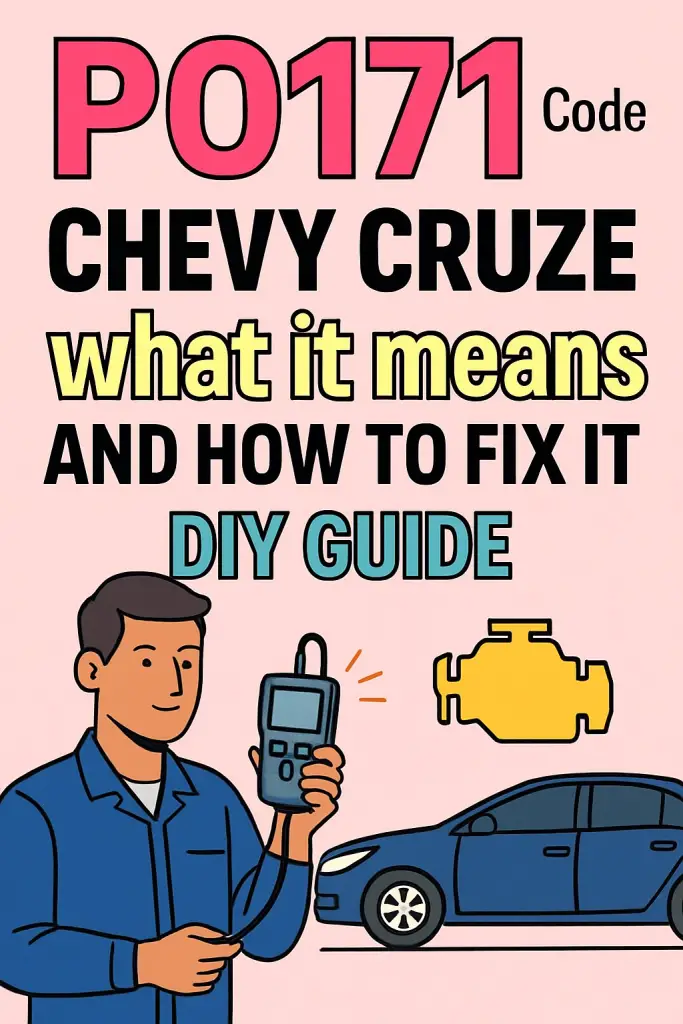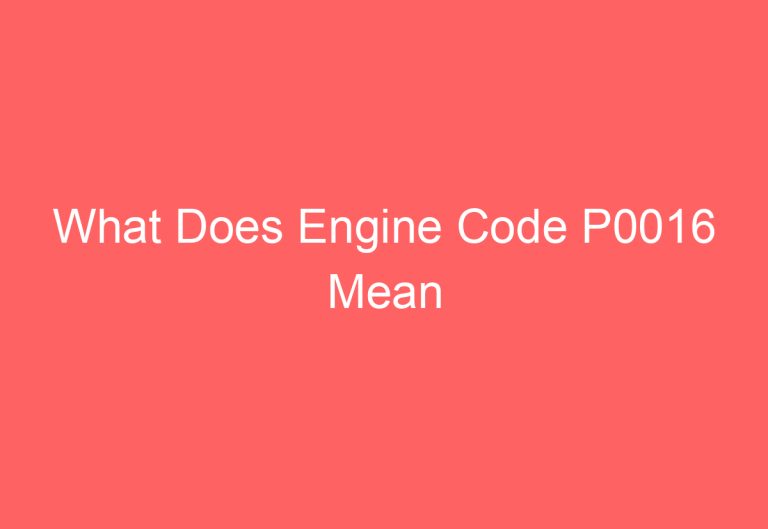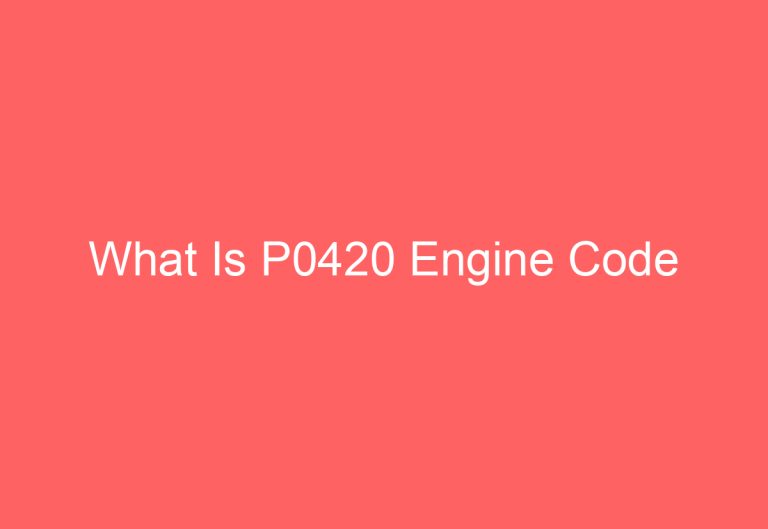P0171 Code Chevy Cruze: What It Means and How to Fix It

When That Check Engine Light Pops Up
You’re cruising down the road in your Chevy Cruze, everything seems fine, and then—bam!—that dreaded check engine light decides to make an appearance. If you plug in a scanner and see P0171, you’re probably thinking: “What on earth does that even mean?”
Trust me, I’ve been there. A couple of years ago, my Cruze threw this exact code, and like many of you, I had to figure out whether it was something minor or a wallet-draining nightmare. Good news? The P0171 code isn’t usually catastrophic, but it does need attention.
Let’s break it all down together in plain English—what it means, why it happens, and exactly how you can fix it without pulling your hair out.
What Does the P0171 Code Mean?
The P0171 OBD-II trouble code translates to: “System Too Lean (Bank 1).”
Sounds fancy, right? Here’s the simple version:
- “Too lean” means your engine is getting too much air and not enough fuel in the air-fuel mixture.
- “Bank 1” refers to the side of the engine that houses cylinder #1. (On the Cruze’s inline 4-cylinder, that’s the only “bank,” but manufacturers still use the same terminology.)
In other words, your Cruze’s engine computer (ECM) noticed that the oxygen sensors detected a lean condition, and it set the code to let you know.
Why Does It Matter?
If your car keeps running lean, you’ll experience:
- Rough idle or stalling
- Sluggish acceleration
- Poor fuel economy (ironic, right?)
- Potential long-term engine damage if ignored
Common Symptoms of P0171 on a Chevy Cruze
If you’re seeing P0171, you might notice some (or all) of these symptoms:
- Check Engine Light (obviously)
- Rough idling or occasional misfires
- Weak acceleration—the car feels like it’s dragging
- Higher fuel consumption (even though the code means “too lean,” the ECM may compensate by adding more fuel)
- Whistling or hissing noise (a vacuum leak giveaway)
Ever felt like your Cruze just doesn’t have the pep it used to? Yep, that’s the code talking.
What Causes P0171 in a Chevy Cruze?
Here’s the part where things get interesting. The P0171 code can be caused by several culprits. Let’s run through the most common ones:
1. Vacuum Leaks
- Cracked or disconnected vacuum hoses
- PCV (positive crankcase ventilation) system issues
- Intake manifold gasket leaks
2. Dirty or Faulty Mass Air Flow (MAF) Sensor
The MAF sensor measures incoming air. If it’s dirty or malfunctioning, it’ll give bad readings and trick the ECM into thinking there’s more air than fuel.
3. Faulty Oxygen (O2) Sensors
The upstream O2 sensor monitors oxygen in the exhaust gases. If it’s failing, it may incorrectly report lean conditions.
4. Fuel Delivery Problems
- Weak fuel pump
- Clogged fuel filter
- Dirty fuel injectors
5. Exhaust Leaks (Before O2 Sensor)
A small crack in the exhaust manifold or pipe before the sensor can cause skewed readings.
👉 FYI: On the Cruze, vacuum leaks and MAF sensor problems are by far the most common causes.
How to Diagnose the P0171 Code in a Chevy Cruze
You don’t need to be a pro mechanic to track this down. Here’s a step-by-step guide you can try before dropping hundreds at a shop.
Step 1: Use an OBD-II Scanner
- Confirm that the code is indeed P0171.
- Check for additional codes (like P0106, P1101, or P0300) that could point to related issues.
Step 2: Visual Inspection
- Look for loose hoses, cracked rubber lines, or disconnected fittings.
- Pay extra attention to the PCV valve and intake system.
Step 3: Listen for Hissing
With the engine idling, listen closely near the intake manifold. A hissing sound usually means a vacuum leak.
Step 4: Check the MAF Sensor
- Inspect it for dirt or debris.
- If it looks grimy, remove and clean it using MAF sensor cleaner spray (never use carb cleaner—it’ll ruin it).
Step 5: Test Fuel System Pressure
If you have a fuel pressure gauge:
- Connect it to the rail.
- Compare the reading to factory specs (usually around 50–60 PSI for the Cruze).
Step 6: Inspect O2 Sensors
If everything else checks out, consider testing or replacing the upstream O2 sensor.
DIY Fixes for P0171 in a Chevy Cruze
Here’s the part we all care about: fixing it. Let’s tackle the easy stuff first.
Clean the MAF Sensor
- Remove the sensor from the intake tube.
- Spray with MAF sensor cleaner.
- Let it dry and reinstall.
- Reset the code and test drive.
Check and Replace PCV Valve
The Cruze is notorious for PCV valve diaphragm tears, which cause vacuum leaks. If you notice oil around the valve cover or hear a whistling noise, this could be the culprit.
Inspect and Replace Hoses
- Replace any cracked or brittle vacuum hoses.
- Tighten hose clamps on the intake system.
Replace Intake Manifold Gasket
If you suspect a leak, a smoke test can confirm it. Replacing the gasket is more involved but doable for a DIYer.
Fuel System Fixes
- Swap the fuel filter if it’s clogged.
- Use a fuel injector cleaner additive.
- If pressure is low, the fuel pump may need replacement.
O2 Sensor Replacement
If cleaning the MAF and fixing leaks don’t solve it, replacing the upstream O2 sensor may finally clear the code.
Estimated Repair Costs
Wondering what kind of damage this might do to your wallet? Here’s a ballpark idea (DIY vs. shop):
- MAF sensor cleaning: $10 (DIY), $80–$120 (shop)
- Vacuum hose replacement: $20–$100 (DIY), $150–$250 (shop)
- PCV valve: $30–$60 (DIY), $150–$200 (shop)
- Fuel pump: $150–$300 (DIY), $600–$900 (shop)
- O2 sensor: $70–$120 (DIY), $200–$350 (shop)
Not all fixes are budget killers, thankfully.
Can You Still Drive with a P0171 Code?
Technically, yes—you can still drive with the code active. But should you? Probably not for long.
Driving too lean can cause:
- Overheating in the combustion chamber
- Pre-ignition (knocking)
- Long-term engine wear
So if you want your Cruze to keep cruising for years to come, get this fixed sooner rather than later.
Pro Tips to Prevent P0171 from Coming Back
Once you’ve fixed it, here’s how to avoid seeing this pesky code again:
- Use high-quality fuel—cheap gas often has additives that clog injectors.
- Replace air filters regularly. A dirty filter can mess with airflow.
- Check hoses during oil changes. Quick inspection saves big headaches.
- Clean the MAF sensor every 15–20k miles. Cheap, easy, and effective.
Conclusion: Don’t Let P0171 Ruin Your Drive
So there you have it: P0171 on a Chevy Cruze basically means your engine is running lean. The usual suspects? Vacuum leaks, dirty MAF sensors, or fuel delivery issues.
Fixing it isn’t rocket science—you can often solve it with a little cleaning, hose replacement, or a new PCV valve. And even if it does come down to an O2 sensor or fuel pump, at least now you know what you’re up against.
Remember, a check engine light isn’t the end of the world—it’s just your Cruze’s way of saying, “Hey buddy, I need a little attention.”
So grab your scanner, pop the hood, and show that P0171 who’s boss. 🚗💨

![How To Fix 7Eb Engine Code [Answered]](https://automotiveglory.com/wp-content/uploads/2024/05/how-to-fix-7eb-engine-code-answered_6103-768x529.jpg)
![How To Check Service Engine Soon Code [Explained]](https://automotiveglory.com/wp-content/uploads/2024/05/how-to-check-service-engine-soon-code-explained_6095-768x529.jpg)



